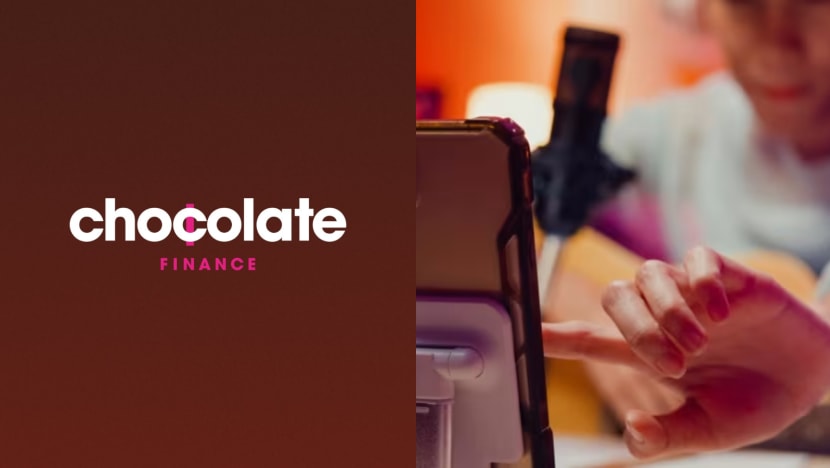Commentary: How financial influencers can make or break investment platforms like Chocolate Finance
Influencers contributed to the rapid growth of Singapore financial services firm Chocolate Finance, but also to its upheaval, says NUS Business School’s Daniel Rabetti.

Influencers play an increasingly pivotal role in shaping public perception of financial products and services. (Photos: Facebook/Chocolate Finance; iStock)

This audio is generated by an AI tool.
SINGAPORE: For financial services firm Chocolate Finance, what should have been a routine liquidity management measure spiralled into a crisis in early March.
The saga began when the company ceased to allow customers to earn miles from AXS payments. Personal finance influencers caught on and announced they were withdrawing their money from Chocolate Finance, spurring more customers to do the same.
Chocolate Finance thus suspended instant withdrawals due to “high demand” on Mar 10. It acknowledged that the change in its reward programme could have been communicated better.
This incident, resembling a digital-era "bank run", highlights the influence that social media personalities wield over financial platforms and the vulnerabilities that arise when investment decisions are led by online sentiment.
INFLUENCER POWER IS A DOUBLE-EDGED SWORD
Influencers play an increasingly pivotal role in shaping public perception of financial products and services. They can drive user adoption of new platforms or trigger mass withdrawals based on their endorsements or criticisms.
In the case of Chocolate Finance, influencers initially contributed to its rapid growth by touting its initial high-yield offering of 4.5 per cent per annum on the first S$20,000 (US$14,850) invested. Their posts helped establish trust in the platform, attracting thousands of users eager for returns that seemed superior to traditional savings accounts.
However, the very same influence that fuelled Chocolate Finance’s rise contributed to its upheaval. When prominent figures began withdrawing funds and expressing concerns over the platform’s liquidity, a ripple effect ensued. Their followers, many of whom lack deep financial expertise, interpreted these actions as a signal that their money was at risk.
Consequently, the influx of withdrawal requests overwhelmed the platform’s ability to process them instantly, reinforcing fears that Chocolate Finance was facing insolvency.
This scenario is not unique. A striking example is Argentine President Javier Milei, who has openly embraced Bitcoin and criticised traditional financial institutions. Recently, he promoted the $Libra memecoin, which surged to a US$4.4 billion market capitalisation before crashing by over 95 per cent.
Insiders reportedly pocketed US$87 million before the collapse, leaving around 40,000 investors with significant losses. As the market tanked, Milei deleted his promotional tweet and distanced himself from the project, claiming he was unaware of its specifics before endorsing it.
HIGHER RETURNS, HIGHER RISKS
The appeal of platforms like Chocolate Finance is largely driven by their promise of high returns. However, higher returns typically come with higher risks. When financial products offer yields that significantly exceed those of traditional banks, consumers must question the sustainability of such returns.
Chocolate Finance’s model relied on investing user deposits in bond funds, which, while generally safer than equities, still carry interest rate and credit risks. As interest rates fluctuate, bond prices can decline, affecting the platform’s liquidity.
If a surge in withdrawals forces the liquidation of bonds at unfavourable prices, financial stress ensues.
In the worst cases, influencers with undisclosed financial interests may promote platforms aggressively, leaving followers vulnerable to unexpected losses. The rapid rise and subsequent collapse of the $TRUMP memecoin, touted by US President Donald Trump, exemplifies this danger. After peaking above US$70 in January, it has since plummeted to around US$10.
INVEST WISELY
Given the growing role of influencers in financial decision-making, consumers must develop critical thinking skills to navigate the hype. Here are a few key considerations:
First, consumers must understand the distinction between regulated financial institutions and platforms offering discretionary fund management.
While Chocolate Finance is licensed as a fund manager by the Monetary Authority of Singapore (MAS), it is not a bank. Banks are regulated under a banking license, subject to stricter capital requirements, depositor protection schemes, and covered by the Singapore Deposit Insurance Corporation.
Financial platforms operate under a Capital Markets Services License for fund management activities. They have more flexibility in operation but fewer safeguards for consumer funds.
Second, before committing any money, investors should ask a fundamental question: How is this platform generating such high returns? If returns appear unusually high and there’s no clear explanation, that should raise eyebrows. A lack of transparency is often a hallmark of unsustainable or even fraudulent schemes.
Consumers should expect and demand straightforward, accessible information about what kinds of assets their money is being invested in; the risks associated with those assets; how returns are generated; and any fees or commissions involved.
If a platform can’t explain its investment model in plain language – or if it focuses more on marketing hype than financial substance – investors should think twice.
Moreover, liquidity risk should not be overlooked. Consumers should assess whether they can withdraw funds freely or if restrictions apply. The sudden suspension of instant withdrawals at Chocolate Finance illustrated how even seemingly stable platforms can face liquidity constraints.
Lastly, consumers must be aware of influencer motivations. Not all influencers have their audience’s best interests at heart. Some receive compensation for promoting financial products, while others may act out of self-interest. Consumers should seek diverse perspectives and cross-reference information from independent financial experts before making investment decisions.
The Chocolate Finance case serves as a cautionary tale about the perils of financial decision-making based on social media trends. While financial influencers can provide valuable guidance, they should not replace due diligence and independent financial analysis.
Daniel Rabetti is an Assistant Professor at the Department of Accounting and Finance, National University of Singapore Business School. The opinions expressed are those of the writer and do not represent the views and opinions of NUS.


















